Readings Newsletter
Become a Readings Member to make your shopping experience even easier.
Sign in or sign up for free!
You’re not far away from qualifying for FREE standard shipping within Australia
You’ve qualified for FREE standard shipping within Australia
The cart is loading…






This title is printed to order. This book may have been self-published. If so, we cannot guarantee the quality of the content. In the main most books will have gone through the editing process however some may not. We therefore suggest that you be aware of this before ordering this book. If in doubt check either the author or publisher’s details as we are unable to accept any returns unless they are faulty. Please contact us if you have any questions.
The book Universality of semantic frames and language specific Bulgarian data is devoted to the principles of data organisation in the Bulgarian FrameNet, which has been in development for more than 20 years and has gone through various phases. Originally it was developed as an independent resource, but for about fifteen years it has been correlated with the Berkeley FrameNet, observing the following basic principles: The information in the FrameNet that is relevant for the description of Bulgarian is considered language-independent (e.g. definition of frames and relations between them, definitions of frames and elements and relations between them, etc.) and is automatically transferred into a structure called a superframe. For each superframe, there may be one or more Bulgarian frames in which the language-independent information is restructured, if necessary, so that it corresponds exactly to the description for the Bulgarian language. The Bulgarian verbs of communication, change, movement, contact and emotion are described in more detail, their subclasses are delineated and the similarities and differences in the semantic and syntactic description for Bulgarian and English are compared and discussed. It is shown how the semantic frames can be used in an experiment to assess children's mastery of semantic conceptualisation and syntactic use of verbs from their basic vocabulary. These and a number of other applications: automatic assignment of semantic roles, automatic recognition of events in news, automatic recognition of scenes in images and videos are some of the applications in which the Bulgarian FrameNet can be used. In addition, the semantic and syntactic information in the Bulgarian FrameNet can be used for theoretical considerations, including comparative studies focussing on the modern state of the Bulgarian language and other languages for which a FrameNet has been developed.
$9.00 standard shipping within Australia
FREE standard shipping within Australia for orders over $100.00
Express & International shipping calculated at checkout
This title is printed to order. This book may have been self-published. If so, we cannot guarantee the quality of the content. In the main most books will have gone through the editing process however some may not. We therefore suggest that you be aware of this before ordering this book. If in doubt check either the author or publisher’s details as we are unable to accept any returns unless they are faulty. Please contact us if you have any questions.
The book Universality of semantic frames and language specific Bulgarian data is devoted to the principles of data organisation in the Bulgarian FrameNet, which has been in development for more than 20 years and has gone through various phases. Originally it was developed as an independent resource, but for about fifteen years it has been correlated with the Berkeley FrameNet, observing the following basic principles: The information in the FrameNet that is relevant for the description of Bulgarian is considered language-independent (e.g. definition of frames and relations between them, definitions of frames and elements and relations between them, etc.) and is automatically transferred into a structure called a superframe. For each superframe, there may be one or more Bulgarian frames in which the language-independent information is restructured, if necessary, so that it corresponds exactly to the description for the Bulgarian language. The Bulgarian verbs of communication, change, movement, contact and emotion are described in more detail, their subclasses are delineated and the similarities and differences in the semantic and syntactic description for Bulgarian and English are compared and discussed. It is shown how the semantic frames can be used in an experiment to assess children's mastery of semantic conceptualisation and syntactic use of verbs from their basic vocabulary. These and a number of other applications: automatic assignment of semantic roles, automatic recognition of events in news, automatic recognition of scenes in images and videos are some of the applications in which the Bulgarian FrameNet can be used. In addition, the semantic and syntactic information in the Bulgarian FrameNet can be used for theoretical considerations, including comparative studies focussing on the modern state of the Bulgarian language and other languages for which a FrameNet has been developed.